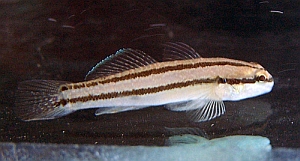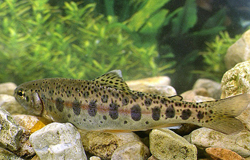
|
|
Notes on Fish of San Franscisco Bay Area Chameleon Goby - Tridentiger trigonocephalus Photo credit USGS  Steelhead Trout - Oncorhynchus mykiss Detailed notes about some species of fish. Chameleon Goby - Tridentiger trigonocephalusChameleon Gobies are called such because of their ability to change their coloration. They may have two black stripes running down the length of their gray body or they may completely change their pattern to a series of brown, vertical bars in a matter of seconds. They are bottom-dwellers that eat marine worms, amphipods (small crustaceans), and most other things they can find on the bay floor. Like all gobies, they have two united pelvic fins which form a suction cup on their underside that allows them to stay on a surface in one place even during strong currents. Their body length is 3 to 5 inches.
As fry, they are eaten by crabs, birds, and larger fish.Their food is primarily worms and amphipods. Male gobies build nests for the eggs that a female will lay, usually in old clam or oyster shells. If no shells are available, they will choose a crevice such as a discarded bottle. Chameleon gobies are an invasive species. They are native to brackish and marine waters off the coast of China, Korea, and Japan. They first appeared in the San Francisco Bay in 1962 likely transported by ships’ ballast water. As with all invasive species, it is possible that they are impacting the populations of native estuarine fish, however, they are now well established and are common in the channels under the Hayward Shoreline Interpretive Center. (Information from article by Linden Rayton, Hayward Shoreline Interpretive Center in their newsletter Tidal Tales.) Starry Flounder - Platichthys stellatusThe Starry Flounder is named for the round bumps seen on its upper side known as stellate scales which give it a starry appearance. The scientific name, Platichthys stellatus, is Greek for starry flat fish. They are also known for their orange and black stripes on their fins. Starry Flounders can grow up to three feet long and up to 20 pounds over two to three years time and can live about 24 years. Like other flatfish, starry flounders have the ability to lay flat on the bottom of the sea floor on either their right or left side. Starry Flounders can be found in two zones beginning in Alaska. One zone will end in southern California, and the other will span into Korea and Japan. This includes tidal areas with sandy or mud bottoms, usually bays and river estuaries. However, they can also live in ocean waters up to 900 feet deep. The flounder is usually more inland in the summer months due to spawning in shallow water and move to deeper waters for the winter. Flounders begin their lives as typical fish, swimming upright. However once juveniles, these fish move one eye to the other side of their head. Interestingly, about 60% of flounders have both eyes on the left side and 40% have them on the right. This enables the fish to swim on their side while on the bottom, but continue to retain adequate vision for hunting prey, which include crustaceans, worms, small mollusks, brittle stars, and small fish. Flounders are sometimes difficult to spot. Their stellate scales help them blend into the sand. In addition, they will bury themselves and camouflage in the sand to hide from predators and to lay in wait for unnoticing prey. (Information from article by Melissa Fowlks, Hayward Shoreline Interpretive Center in their newsletter Tidal Tales.) Plainfin Midshipman - Porichthys notatusMales produce a "hum" to attract females to their nesting site. This loud droning hum can be heard by nearby humans. These fish are to blame for past stories of “generator-like” noise complaints in Sausalito, CA. These fish have hundreds of photophores along their body which are used to produce light.
Topsmelt Silverside - Atherinops affinis
Shiner Surfperch - Cymatogaster aggregataAll Surfperch are viviparous: instead of the female laying eggs, she gives birth to live young. The size of the litter for a Shiner Surfperch varies between 4 and 25 individuals. They emerge as fully-developed, miniature adults. Mating in shiner surfperch takes place during the summer. Courting males change color from silver to a dark gray or nearly black. The young shiner surfperch are born the following spring or summer. Shiner Surfperch are one of the most abundant surfperch found along California’s coastline, yet they are often overlooked and treated as mere bait fish. Though they seem drab in coloration from a distance, upon closer inspection you will notice the beautiful distinctive yellow bars on both sides of the fish. In the wild, the average lifespan of the Shiner Surfperch is between 6-8 years, and they grow to a maximum length of 7 inches. They are only found in the Eastern Pacific Ocean in a range that spans San Quintin Bay in Baja California, all the way up the coast to Port Wrangell, Alaska. Their diet consists of Small crustaceans, crab larvae, polychaete worms, copepods, amphipods, fish eggs, algae, diatoms. You can find them in calm water near a structure where they can hide from predators. They are commonly found near pilings of piers or even eelgrass beds. If the water is clear enough, you may even have the opportunity to observe the Shiner Surfperch practicing one of their favorite tricks: nipping the feeding appendages of barnacles. (Information from article by Lauren Porter, Hayward Shoreline Interpretive Center in their newsletter Tidal Tales.) Salmon
|